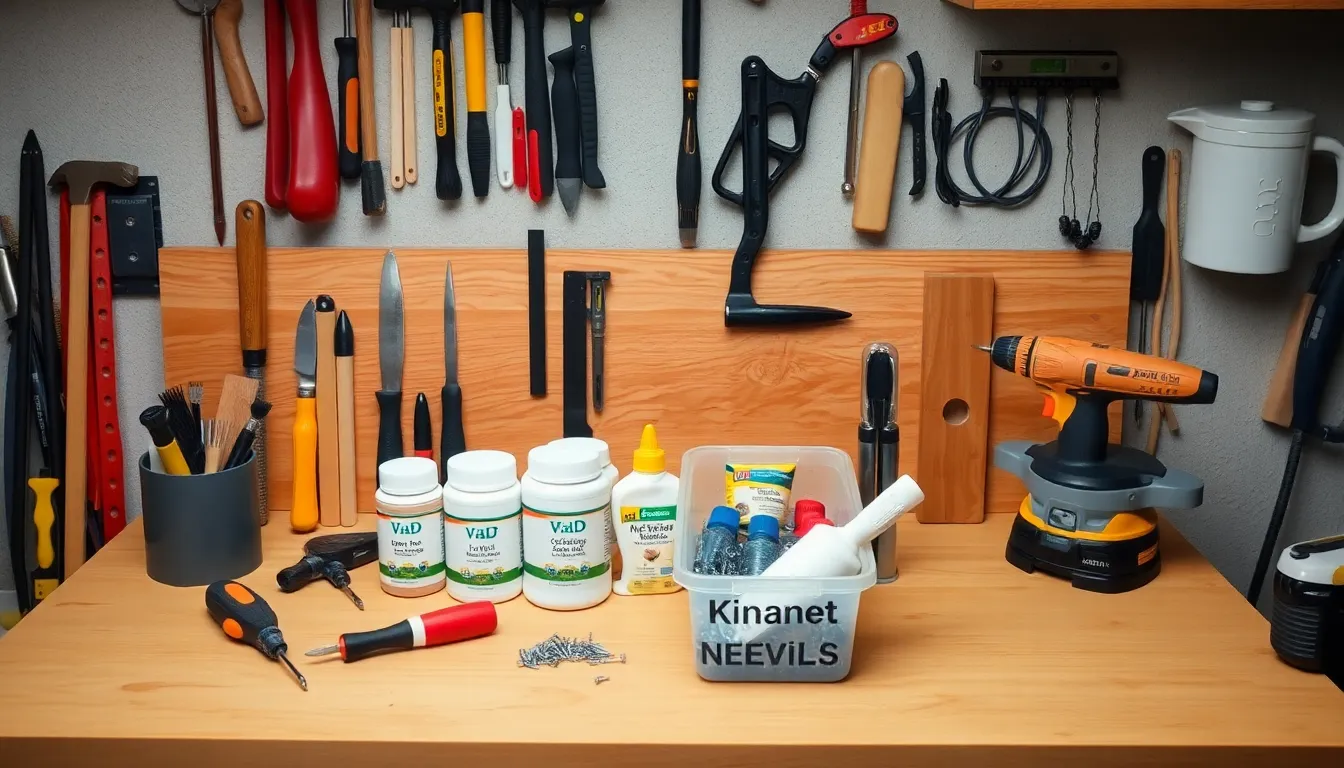Table of Contents
ToggleKitchen cabinets are the unsung heroes of any home, holding everything from pots and pans to that questionable jar of pickles you swear you’ll use someday. But what happens when these loyal companions start to show their age? Scratches, dents, and hinges that squeak louder than a rusty door can turn your culinary haven into a chaotic mess.
Understanding Kitchen Cabinet Repair
Kitchen cabinets face various challenges over time. Recognizing these issues early ensures longevity and optimal performance.
Common Issues with Kitchen Cabinets
Common problems include scratches, dents, and warped doors. Many cabinets also experience issues like loose fittings and broken hinges. Moisture damage can lead to swelling, while paint or lacquer may chip and peel. Accumulated grime on surfaces often affects their appearance and usability. Identifying these concerns promptly enhances the chances of successful repairs.
Importance of Timely Repairs
Timely repairs prevent minor issues from escalating into major problems. Ignored scratches can compromise cabinets’ aesthetics and integrity. Broken hinges disrupt functionality, causing doors to sag or close improperly. Prompt attention to moisture issues prevents further damage and costly replacements. Investing in repairs maintains overall kitchen appeal and value. Regular maintenance also extends the life of cabinets, ensuring they serve well for years to come.
Tools and Materials Needed

Repairing kitchen cabinets requires specific tools and materials for effective results. Understanding what you’ll need streamlines the repair process and enhances efficiency.
Essential Tools for Repairs
- Screwdriver: A Phillips and flathead screwdriver handles screws on cabinet doors and hardware.
- Hammer: Use a hammer for minor adjustments and to secure loose components.
- Drill: A power drill speeds up tasks like installing new hardware or wooden dowels.
- Level: Utilize a level to ensure cabinets align correctly after adjustments.
- Sander: A hand or power sander smooths rough surfaces, preparing them for refinishing.
- Clamps: Clamps hold pieces together while adhesive sets, ensuring proper alignment.
Recommended Repair Materials
- Wood filler: Fill holes and imperfections in wood surfaces effectively.
- Paint or stain: Match existing finishes for a seamless look during touch-ups.
- Adhesive: Use wood glue for reattaching loose parts securely.
- Screws: Choose screws suited for cabinet hardware replacement or reinforcement.
- Cabinet hinges: Upgrading hinges improves functionality and ensures doors operate smoothly.
- Varnish: Protect finished surfaces with varnish to preserve appearance and durability.
Step-by-Step Repair Process
Kitchen cabinet repair involves several essential steps, starting with assessing the damage to determine the best course of action for repairs.
Assessing the Damage
Begin by closely inspecting the cabinets for various issues. Look for scratches, dents, warped doors, and loose fittings. Identify areas with moisture damage, as these often require more extensive repairs. Take notes on each issue, as this helps prioritize tasks. Understanding the extent of the damage aids in planning for repairs efficiently.
Performing Minor Repairs
Tackle minor repairs before moving on to significant issues. Use wood filler to fill in small scratches and dents, ensuring a smooth finish. Tighten loose screws in hinges and fixtures for improved functionality. Sand areas needing attention to prepare for painting or staining. Apply the appropriate paint or stain to match existing finishes. Clamps can hold pieces in place temporarily while adhesive sets.
Refacing or Replacing Cabinets
Consider refacing cabinets when extensive wear is visible but the structure remains sound. Choose veneer or laminate to cover old surfaces, providing a fresh look. This option is typically more cost-effective than complete replacement. If cabinets are severely damaged or outdated, full replacement may be necessary. Measure carefully to ensure new cabinets fit properly. In either case, proper installation is crucial for long-term satisfaction.
Tips for Maintaining Kitchen Cabinets
Maintaining kitchen cabinets keeps them functional and enhances their appearance. Regular care ensures longevity and reduces the need for extensive repairs.
Preventative Maintenance Practices
Cleaning cabinets regularly prevents the buildup of grime and grease. Use a soft cloth and gentle cleaner for this task. Additionally, applying a wood conditioner every few months helps maintain the finish. Inspecting hinges and handles regularly for loose screws prevents future issues. Tighten screws and lubricate hinges to keep doors functioning smoothly. Over time, moisture can damage cabinets, so controlling humidity in the kitchen is essential. Avoid placing hot items directly on the cabinet surfaces; using coasters or mats protects the finish.
Common Mistakes to Avoid
Neglecting cabinet maintenance often leads to expensive repairs. Skipping regular cleaning creates an environment for dirt to accumulate. Using harsh chemicals can damage the cabinet’s finish, so choose safe cleaners instead. Ignoring small repairs can escalate into larger problems, making timely action critical. Overloading cabinets can lead to warping and damage, so be mindful of weight limits. Lastly, repainting or refinishing without proper preparation can result in uneven surfaces. Prioritizing proper care prevents future complications and extends cabinet life.
Addressing kitchen cabinet repairs promptly can make a significant difference in both functionality and aesthetics. By understanding common issues and employing the right tools and materials, homeowners can effectively tackle repairs and maintain their cabinets’ value. Regular maintenance and timely interventions not only enhance the kitchen’s appeal but also extend the lifespan of the cabinets. With a proactive approach and attention to detail, it’s possible to keep kitchen cabinets looking great and working well for years to come. This commitment to care ensures that the heart of the home remains both practical and inviting.





